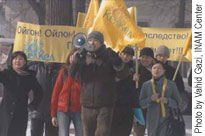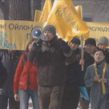
PROTESTORS CLOSE KYRGYZSTAN’S MAJOR TRANSPORTATION ROUTES
Publication: Eurasia Daily Monitor Volume: 2 Issue: 47
By:

The situation in Kyrgyzstan remains very tense following its disputed February 27 parliamentary elections. News reports about massive protest demonstrations organized by the opposition continue to pour in from across the country. In Naryn, a city in central Kyrgyzstan, approximately 600 protesters have been continuously occupying the central city square, immobilizing public transportation. In the village of Karachy, Naryn oblast, demonstrators blocked the Bishkek-Torugart highway, which is the only road connecting Kyrgyzstan with China.
The largest protest actions are concentrated in southern Kyrgyzstan. In Jalalabad, one of the largest cities in southern Kyrgyzstan and the administrative center of the oblast with the same name, hundreds of protesters occupied the regional administration building. Most of the protesters are supporters of the local candidate for a parliamentary seat, Zhusupbek Bakiyev, brother of the prominent opposition figure Kurmanbek Bakiyev. After protesters seized the building, they demanded the resignation of both the local administration and Kyrgyzstan’s President Askar Akayev as well as an annulment of the official results of the February elections.
Another protest took place approximately 50 kilometers west of Jalalabad, in Nooken Raion. About 3,000 supporters of Dooronbek Sadyrbayev, an opposition candidate for parliament, blocked the only highway connecting the southern and northern regions of the country, which are divided by a mountain pass. The situation is also reportedly tense in the nearby Jalalabad-Osh Oblast (southern Kyrgyzstan), where more than 1,500 opposition supporters in the town of Uzgen organized a demonstration in front of the offices of the local administration and subsequently seized the building. The protesters demand new, fair parliamentary elections (Akipress, March 6-7).
The current protest actions are hardly a surprise. On election day, opposition leader and former minister of foreign affairs Roza Otunbayeva bluntly told Jamestown that the opposition would attempt to repeat the Ukrainian and Georgian scenarios in Kyrgyzstan. However, in the Kyrgyz version, the opposition might lose control of the situation, allowing a desired “velvet revolution” to turn into a bloody revolt.
Opposition leaders fully understand the danger of the situation. According to the deputy chairman of the Democratic Movement of Kyrgyzstan, Isenge Boldzhurova, there is a danger that the events in Jalalabad might follow the Aksy pattern. (On March 15, 2002, six protesters were killed in clashes between demonstrators and police in the village of Aksy, Jalalabad Oblast.)
At a March 7 press conference organized in Bishkek, Boldzhurova noted that the authorities had dispatched about 300 soldiers from the forces of the Ministry of Internal Affairs to the vicinity of Jalalabad (Akipress, March 7). Boldzhurova also told Jamestown that the authorities are deliberately trying to provoke bloody clashes. “Recently so-called ‘popular brigades’ were created under the police umbrella and, as a rule, these formations consist mostly of former convicts. It cannot be ruled out that the members of these brigades will be used as provocateurs so that it would be possible to blame the clashes on the opposition.” However, according to President Akayev’s press secretary, Abdil Segizbayev, “The opposition in the republic will use all opportunities in order to provoke the authorities to implement extraordinary measures. But they will not be able to achieve this objective” (Akipress, March 7).
Ethnicity also plays a very important role in the current standoff. Uzbeks comprise about one-third of the population of southern Kyrgyzstan. Relations between Uzbeks and Kyrgyz are quite tense. For example, in 1990 clashes between Uzbek and Kyrgyz residents in Osh Oblast claimed the lives of 320 people. The majority of the demonstrators in southern Kyrgyzstan are ethnic Kyrgyz, while an Uzbek won the parliamentary seat for the city of Jalalabad, which is contested by the opposition.
In reality, the opposition is rallying because of purely political demands. However, many poorly educated local Uzbeks suspect that the opposition is also motivated by nationalist sentiments. Azimzhon Askarov, a human rights activist from Bozor-Qurghan, an Uzbek-dominated district center approximately 30 kilometers west of Jalalabad, told Jamestown that the tragedy of 1990 has not been forgotten and that current events might provoke new clashes.
According to the fergana.ru, website, participants in the Jalalabad demonstration shouted insults against Uzbeks and Kyrgyz. The Uzbeks accused Kyrgyz of destabilizing the situation in Kyrgyzstan, while the protesters blamed the Uzbeks for supporting the regime of President Akayev. The mutual verbal accusations soon deteriorated in a brawl. According to witnesses, the special police units and police officers that were guarding the Jalalabad Oblast administration building were in no hurry to intervene (Fergana.ru, March 6).
The seizure of the Uzgen local administrative offices may be a precursor to more dangerous events. In 1990 the largest clashes between Uzbeks and Kyrgyz took place precisely in this Uzbek-dominated district center. According to the former Mufti of Kyrgyzstan and the chairman of the international Islamic center, Sadykzhan Kamaluddin, virtually all protesters who occupied the Uzgen building are Kyrgyz from nearby villages.




